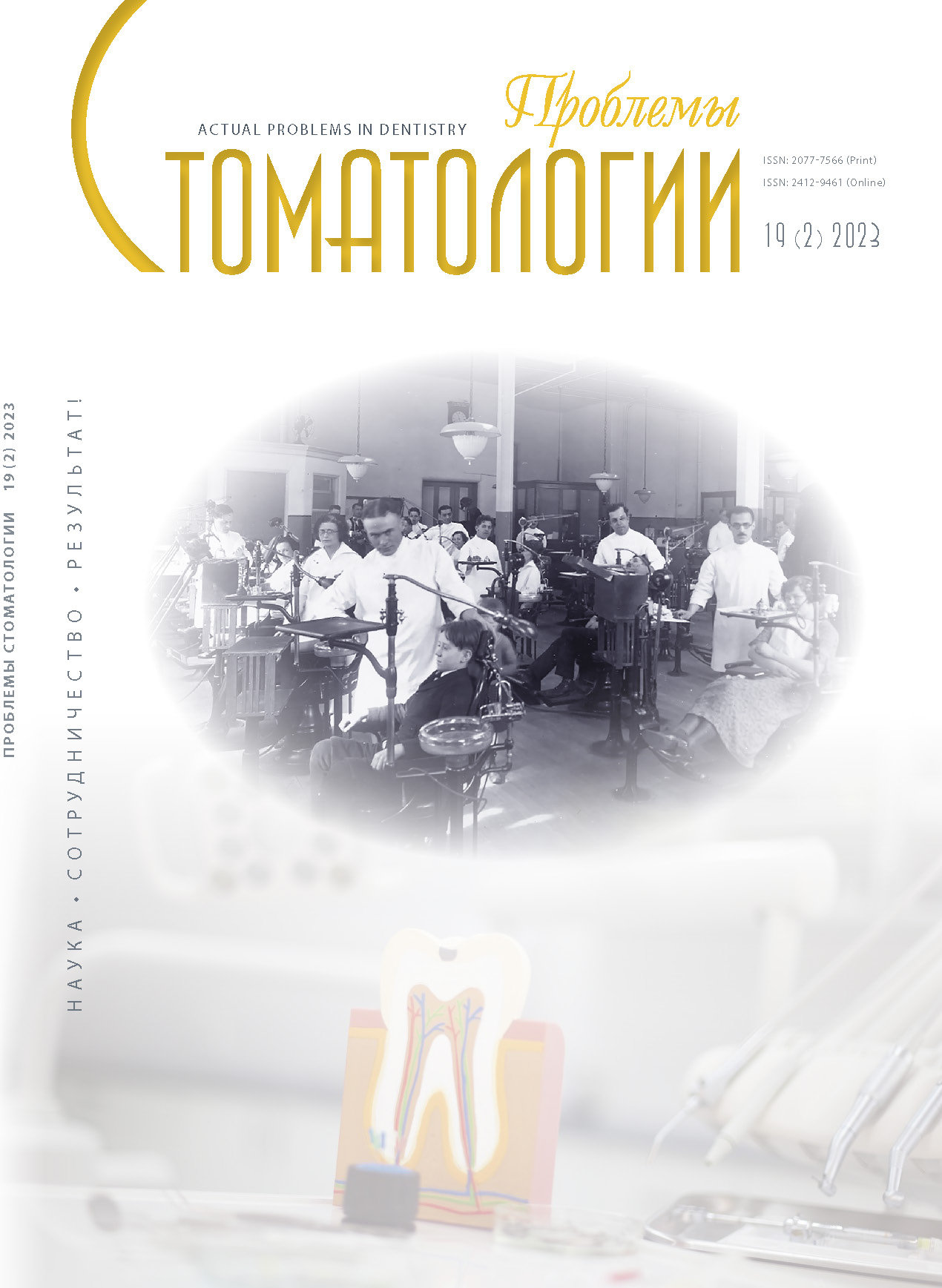from 01.01.2022 until now
St. Petersburg, St. Petersburg, Russian Federation
VAK Russia 3.1
VAK Russia 3.1.7
UDC 616
CSCSTI 76.29
Introduction. Creating high-quality interdental contacts is the most important and difficult step in the treatment of proximal caries. In modern dentistry, most methods for restoring the proximal wall of teeth involve the use of dental matrices. The choice of matrix and the peculiarities of working with it are the determining factor in the formation of the proximal contour of the tooth and often causes difficulties, especially for young specialists. The aim of the study is to conduct an experimental-mathematical determination of the tensile strength of dental matrices to elastic deformation based on the curvature of the proximal surface of the chewing teeth. Materials and methods. The work consisted of 2 stages. Initially, a test bench was developed to assess the deformation capabilities of dental matrices, consisting of a strain gauge and a model of the proximal tooth wall with the possibility of fixing the matrix and imitating pushing. The model was created in SolidWorks software and 3D printed from light-cured polyamide. At the second stage, computer models of teeth and matrices were created, as well as an analysis of data from x-rays and other sources. Results. In the course of the work, the strength characteristics of dental matrices were obtained, the limits of their deformation capabilities were determined depending on the thickness of the material and the area of impact on it. Titanium matrices have the best strength characteristics, withstanding a force of 70 N, with an impact area of 2.25 mm2. An analysis of the curvature of the proximal surfaces of the chewing teeth revealed the best match between the matrix contour and the tooth contour on the medial surface of the first molars of the upper and lower jaws. Conclusions. To achieve high results in the restoration of the proximal walls of the teeth, in most cases it is recommended to press the matrix with an instrument with a working area of at least 2 mm2.
treatment of proximal caries, dental matrices, matrix deformation, anatomical adaptation, tooth contour
1. Cervino G. et al. Dental restorative digital workflow: digital smile design from aesthetic to function // Dentistry journal. - 2019,7(2):30. https://doi.org/10.3390/dj7020030
2. Blatz M.B. et al. Evolution of aesthetic dentistry // Journal of dental research. - 2019;98(12):1294-1304. https://journals.sagepub.com/doi/pdf/10.1177/0022034519875450
3. Nelson S.J. Wheeler’s Dental Anatomy, Physiology, and Occlusion. 10th ed. 2015:350. https://www.amazon.com/Wheelers-Dental-Anatomy-Physiology-Occlusion/dp/0323263232
4. Byun S.J. et al. Analysis of proximal contact loss between implant-supported fixed dental prostheses and adjacent teeth in relation to influential factors and effects. A cross-sectional study // Clinical oral implants research. - 2015;26(6):709-714. https://doi.org/10.1111/clr.12373
5. Kaur P. et al. Impact of dental disorders and its influence on self esteem levels among adolescents // Journal of clinical and diagnostic research: JCDR. - 2017;11(4):ZC05. doi:https://doi.org/10.7860/JCDR/2017/23362.9515
6. Jafri Z. et al. Digital Smile Design-An innovative tool in aesthetic dentistry // Journal of oral biology and craniofacial research. - 2020;10(2):194-198. https://doi.org/10.1016/j.jobcr.2020.04.010
7. Scutariu M.M. et al. Importance of dental maxillofacial aesthetics in dental therapy // The Medical-Surgical Journal. - 2016;120(4):926-931. https://www.revmedchir.ro/index.php/revmedchir/article/view/187/159
8. van Beek H. The transfer of mesial drift potential along the dental arch in Macaca irus: an experimental study of tooth migration rate related to the horizontal vectors of occlusal forces // Eur J Othod. - 1979;1(2):125-129. DOI:https://doi.org/10.1093/ejo/1.2.125
9. Boushell L.W., Sturdevant J.R. Clinical significance of dental anatomy, histology, physiology, and occlusion // Sturdevant’s Art & Science of Operative Dentistry. - 2019:1-40. https://books.google.ru/books?hl=ru&lr=&id=4bZEDwAAQBAJ&oi=fnd&pg=PA1&dq=functional+dentistry+proximal+contact&ots=7T2fdJM7du&sig=p7eod_pp6ZUc4O5gAMEpTQrTcT0&redir_esc=y#v=onepage&q=functional dentistry proximal contact&f=false
10. Liang C.H. et al. The prevalence and associated factors of proximal contact loss between implant restoration and adjacent tooth after function: a retrospective study // Clinical implant dentistry and related research. - 2020;22(3):351-358. https://doi.org/10.1111/cid.12918
11. Kaswan Neha. et al. Scanning electron microscopic analysis of enamel morphology post interproximal reduction, finishing and sealant application: An in vitro study // Iranian Journal of Orthodontics. - 2021;16.2:1-11. DOI:https://doi.org/10.22034/ijo.2021.543593.1011
12. Pokhojaev A. et al. Examination of the interproximal wear mechanism: Facet morphology and surface texture analysis // Journal of Dental Research. - 2018;97(13):1445-1451. https://doi.org/10.1177/0022034518785140
13. Deepak S., Nivedhitha M.S. Proximal contact tightness between two different restorative materials-An in vitro study // Journal of Advanced Pharmacy Education & Research. - 2017;7(2). https://japer.in/storage/models/article/ogNWzvJKLMK0QHba96zIgiPk1EmDljWzm4aVmfk6CW8iTXWFRsujb3F5eKBo/proximal-contact-tightness-between-two-different-restorative-materials-an-in-vitro-study.pdf
14. Swanson K., Hermanides L. Biomechanics and Function: Altering Paradigms to Treat a Patient’s Esthetic Disability Conservatively // Compendium. - 2020;41(5). https://www.aegisdentalnetwork.com/cced/2020/05/biomechanics-and-function-altering-paradigms-to-treat-a-patients-esthetic-disability-conservatively
15. Dietschi D., Saratti C. M. Interceptive treatment of tooth wear: A revised protocol for the full molding technique // Int. J. Esthet. Dent. - 2020;15:264-286. https://edelweissdr.com/content/publicationsPdf/en/p10.pdf
16. Zeng B.J., Guo Y., Yu R.Y. Effect of the vacuum-formed retainer on preventing the proximal contact loss between implant supported crown and adjacent natural teeth // Journal of Peking University. Health Sciences. - 2018;50(3):553-559. PMID: 29930429
17. Shi L. et al. Digital workflow for proximal adjustment of teeth adjacent to implant-supported fixed restorations using a pre-designed computer-aided grinding guide // Journal of Prosthodontics. - 2023. https://doi.org/10.1111/jopr.13701
18. Bauer J.G., Crispin B.J. Evolution of the matrix for Class 2 restorations // Oper Dent. - 1986;4:1-37. https://pubmed.ncbi.nlm.nih.gov/3543860/
19. Orehova L.Yu., Prohorova O.V., Shefov V.Yu. Kachestvennoe anatomicheskoe vosstanovlenie kontaktnogo punkta zubov - profilaktika lokalizovannyh form zabolevaniy parodonta. Parodontologiya.2020;25(1):10-15. [L.Yu. Orekhova, O.V. Prokhorova, V.Yu. Shefov. High-quality anatomical restoration of the contact point of the teeth - prevention of localized forms of periodontal disease. Periodontology. 2020;25(1):10-15. (In Russ.)]. https://doi.org/10.33925/1683-3759-2020-25-1-10-15.




















